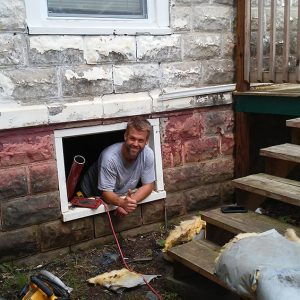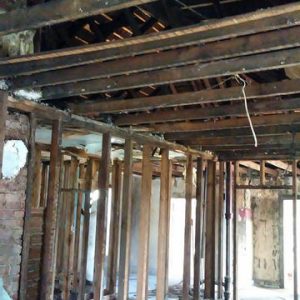What Control Layers in a 100 year old rock face block house??
Not much I can do on the exterior except a proper water blocking concrete stain. My question pertains to the interior. What would be the best practice for the interior control layers, air, vapor and thermal? Local building inspector suggests just kraft backed fiberglass in 2×4 framing. My gut tells me that doesn’t address the problem of air vapor whatsoever and we’ll end up with mold. (also, I can’t put regular 2×4’s directly against concrete and don’t want PT wood off-gassing inside the house for years. He suggested plastic sheets, but that that’s just asking for trouble)
So I am considering Polyiso or EPS or XPS but I’m not sure which (if any). Also I can’t figure out if the boards should be faced with that stuck-on plastic membrane or not? So, in my ignorance, I am imagining the following interior layers:
cement block | 1″ some sort of styrofoam board | 2×4 framing with kraft backed batts
Remember, this is above ground. Not a basement. Does this seem reasonable or am I asking for trouble and should just do what the inspector says.
Thanks in advance.





















Replies
I vote for two inches of XPS, then the 2x4 stud walls (if you can find straight ones for less than the price of metal studs) and unfaced rock wool.
And similar treatment of the basement/crawl space, and rim joists at first and second floor, if that applies.
I hadn't even considered rock wool. Thanks. looking into it now. Better than fiberglass, cheaper than foam. Looks good. Can you tell me why you suggest unfaced?
with a layer of XPS, you would have some vapor control and isolation between those big, wet old blocks and your new studs. I would not want a double vapor barrier.
I think in your zone, you don't strictly need a vapor barrier, but would want to be consistent. having it on the block wall side will help during cooling season, and two inches should be enough to keep the inner interface of the foam at a temperature above the interior dew point most of the heating season. (You should run the numbers to verify.)
https://www.finehomebuilding.com/forum/dew-point-in-wall-calculation-calculator
You probably want to make sure the basement/crawl space floor is taken care of so it does not pump massive amounts of moisture into the house.
Thank you @UncleMike42. This is great information. I had not considered the thickness of the XPS to be a component of the formula. But of course that makes very good sense. I plan on sealing the crawlspace in keeping with the latest wisdom. Thank you again for taking the time to help. I really appreciate it. The insulation guys are going to have a fit when I tell them about rock wool. We are in the boonies out here and anything new makes their heads spin. Looking forward to it.